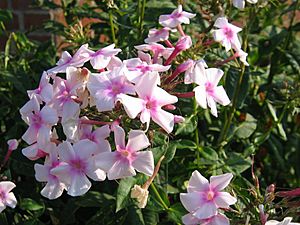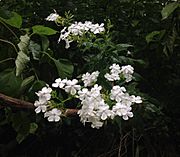Fall phlox facts for kids
Quick facts for kids Fall phlox |
|
|---|---|
 |
|
| Cultivar ‘Eva Cullum’ | |
| Scientific classification | |
| Genus: |
Phlox
|
| Species: |
paniculata
|
Phlox paniculata is a beautiful species of flowering plant often called fall phlox or garden phlox. It belongs to the phlox family. This plant naturally grows in parts of the eastern and central United States. People love to grow it in their gardens in many places around the world because of its pretty flowers. You might also hear it called perennial phlox or summer phlox.
Contents
About the Plant
Phlox paniculata is a tall, upright herbaceous perennial. This means it's a plant with soft stems (not woody like a tree) that lives for more than two years. It can grow up to 120 centimeters (about 4 feet) tall and 100 centimeters (about 3 feet) wide. It has simple leaves that grow in pairs on opposite sides of its slender green stems.
The flowers are about 1.5 to 2.5 centimeters (0.6 to 1 inch) wide. They often smell very nice and bloom from summer through autumn. These flowers grow in large clusters called panicles, which are like many branching flower stems. This is why the plant's scientific name includes paniculata. In the wild, the flowers are usually pink or purple, but sometimes they can be white.
Where It Grows
Fall phlox is originally from parts of the central and eastern United States. It has also spread to other areas, like parts of Canada, Europe, and Asia, where it grows as an introduced species. This means it was brought there by people, rather than growing there naturally.
For example, in the Chicago area, it's not clear if it's truly native or if all the original wild plants were lost. Many of the plants found there now seem to have escaped from gardens into nearby woods and empty lots. In its natural home, you can find it growing along riverbanks and in damp, wooded places.
How to Grow It
People grow Phlox paniculata mostly for its lovely, fragrant flowers that bloom in late summer. To grow it well, you need a spot that is somewhat protected from strong winds. It likes full sun or a little bit of shade, and it needs rich, moist soil to thrive.
You can grow new plants in a few ways. In autumn, you can divide the plant or take root cuttings. In spring, you can take cuttings from the base of the plant. These plants also make great cut flowers for a vase!
If you live in a hot, dry area, these plants can sometimes get a disease called powdery mildew. This makes the leaves look like they're covered in white powder. If you see this, it's best to remove the affected stems right away to help the plant.
Popular Types (Cultivars)
Many different types, called cultivars, have been created for gardens. These are special versions of the plant that have been bred for certain colors or features. The following types have won an award called the Royal Horticultural Society's Award of Garden Merit, which means they are excellent garden plants:
- ’Alba Grandiflora’ (white)
- ’Becky Towe’ (pink, variegated leaves)
- ’Danielle’ (white)
- ’David’ (white)
- ’Eva Cullum’ (deep pink)
- ’Eva Foerster’ (pink/white)
- ’Flamingo’ (bright pink)
- ’Franz Schubert’ (pale pink/purple)
- ’Grenadine Dream’ (red/purple)
- ’Grey Lady’ (lavender-grey)
- ’Luc’s Lilac’
- ’Le Mahdi’ (violet blue)
- ’Miss Elie’ (pink)
- ’Miss Mary’ (deep pink)
- ’Miss Pepper’ (pale pink/deep pink)
- ’Monica Lynden-Bell’ (pale pink)
- ’Mother of Pearl’ (pearl white)
- ’Norah Leigh’ (pale/dark pink, variegated)
- Peacock Cherry Red’
- Peacock Lilac
- Peacock Neon Purple
- Peacock White
- ’Prince of Orange’ (orange-red)
- ’Prospero’ (lilac/white)
- Purple Eye Flame (purple/white)
- ’Rosa Pastell’ (pale pink)
- ’Starfire’ (crimson)
- ’Uspekh’ (violet/white)
- ’Utopia’ (pale pink)
- ’Velvet Flame’ (purple/white)
- ’Visions’ (pale/medium pink)
- ’White Admiral’ (white)
Uses of the Plant
Historically, people have used this plant for simple home remedies. For example, a liquid made from its leaves was sometimes used to help with digestion or to treat skin problems like boils.
See also
 In Spanish: Phlox paniculata para niños
In Spanish: Phlox paniculata para niños




